We may earn revenue from the products available on this page and participate in affiliate programs. Learn More ›
|
Best Overall Binoculars
|
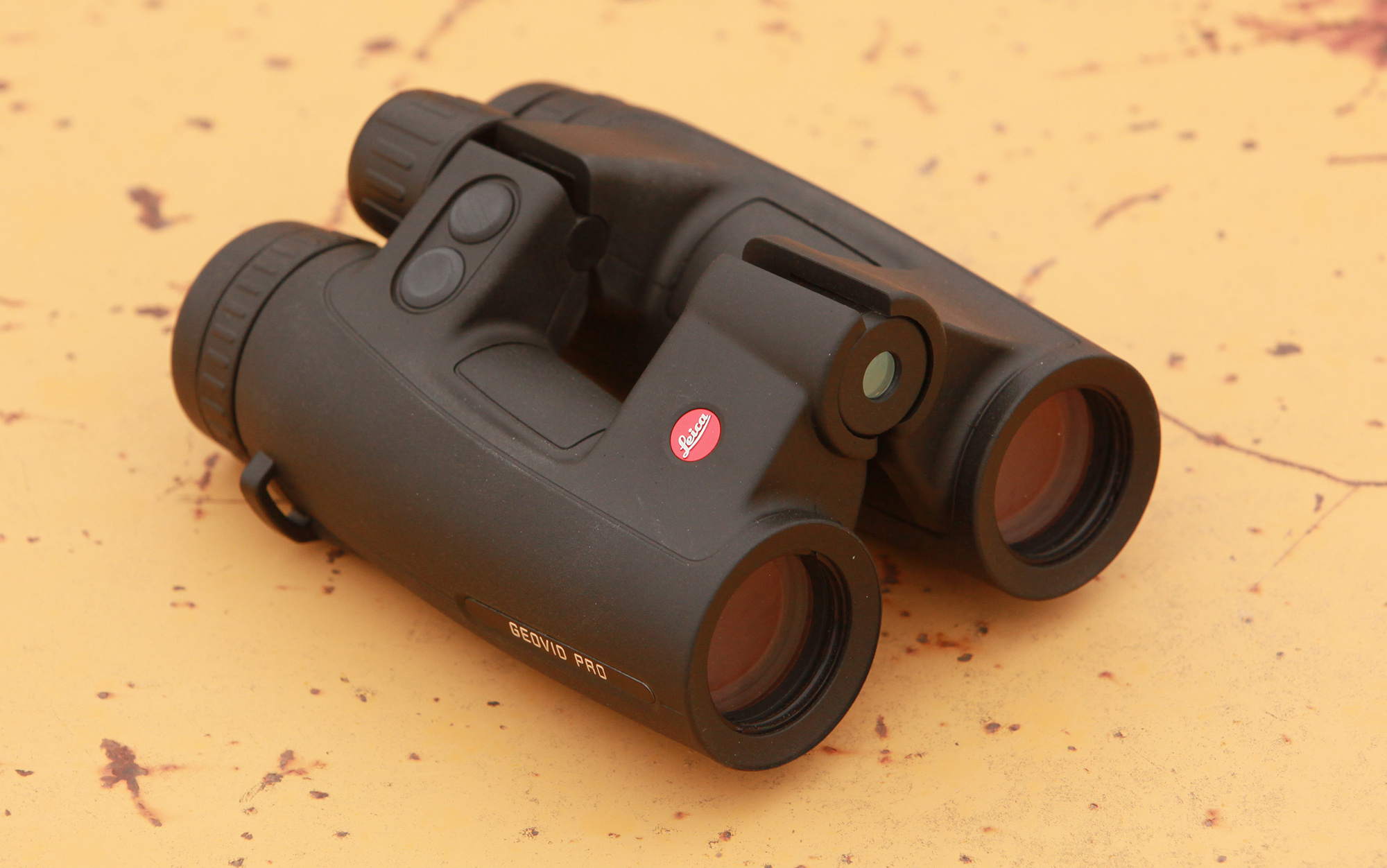
|
Leica Geovid Pro 32 10×32
|
SEE IT
|
|
Best Overall Monocular
|
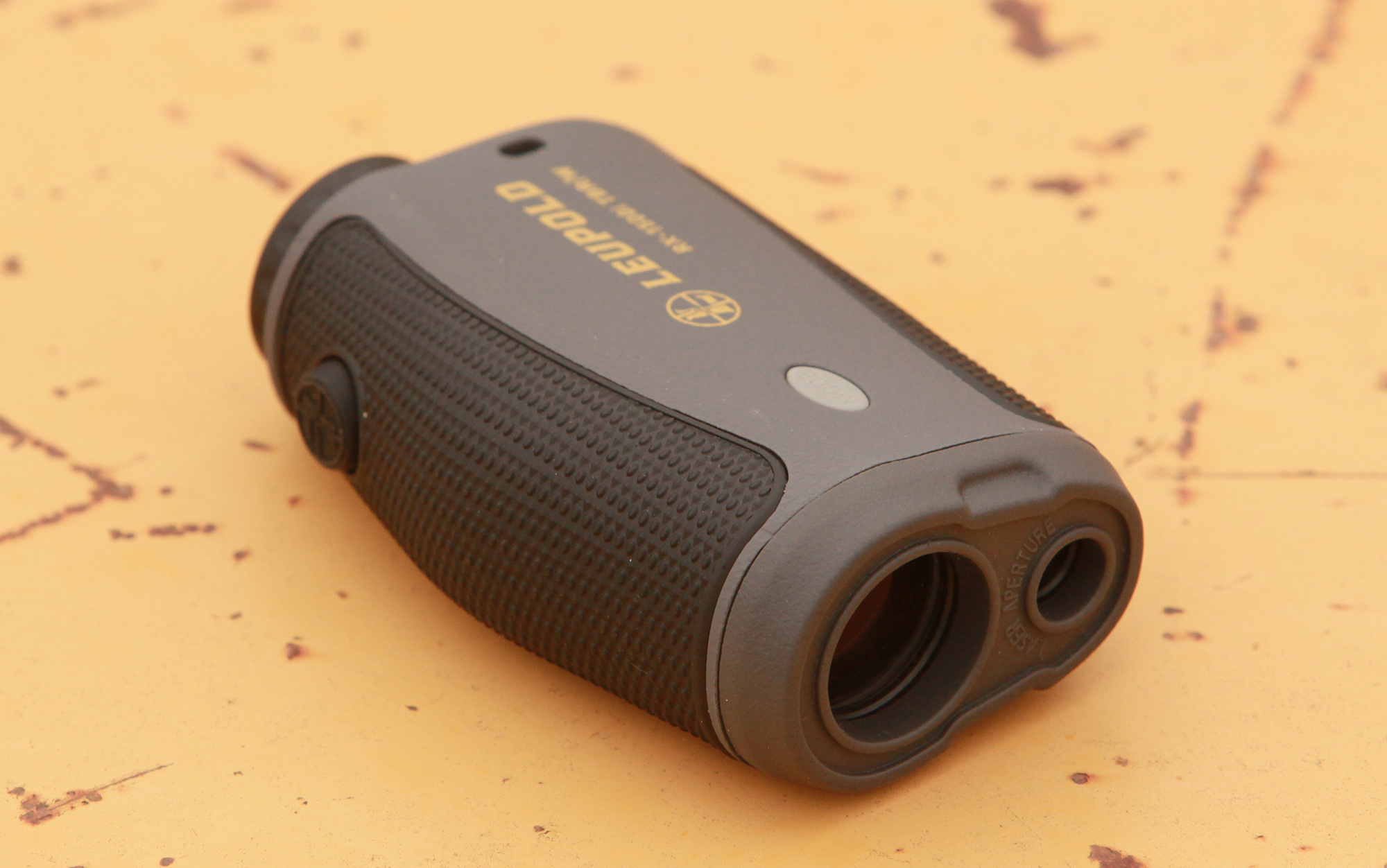
|
Leupold 1500i TBR/W
|
SEE IT
|
|
Best for Archery
|
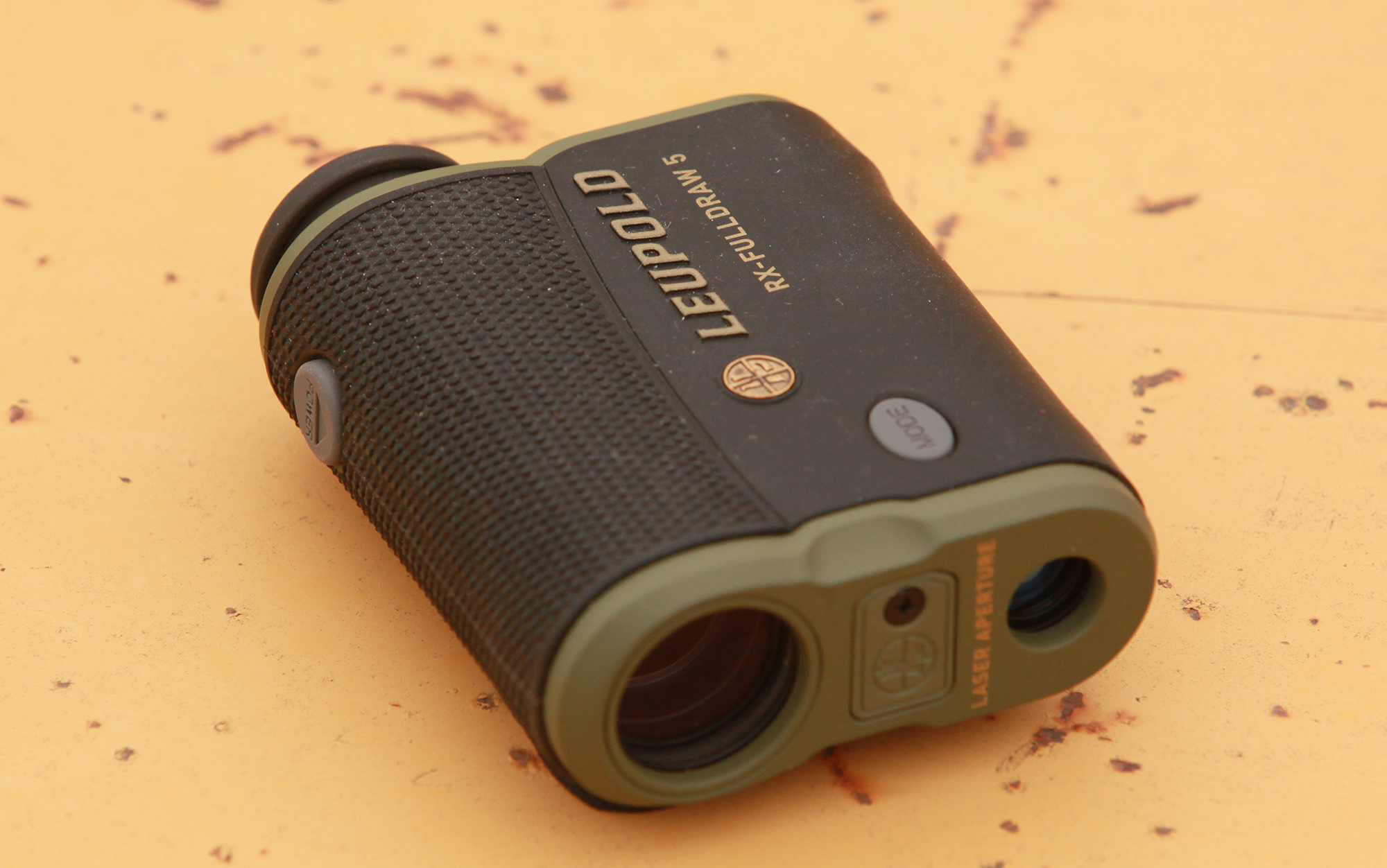
|
Leupold RX-FullDraw 5
|
SEE IT
|
The key to precision shooting and ethical hunting is knowing the exact distance to your target, and there’s no alternative to rangefinders for hunting to guide your shot no matter the landscape or distance. Happily, there’s a model that fits any budget and shooting style. However, the shortcomings and attributes of laser rangefinders are often hard to parse based on marketing materials or even external design.
In order to learn their capabilities, you have to test them in the real world, where you’ll use them. That’s what we did in a variety of terrains, shooting situations, and light conditions in the hopes this review guides both your purchasing decisions and your bullet. The units detailed here were submissions to the 2022 Outdoor Life optics test, which we subjected to a higher level of rigor. They’re all either new models or significant updates to existing models, which is why you won’t see every laser rangefinder on the market listed here.
It’s useful to recognize that we tested both rangefinding binoculars and traditional rangefinding monoculars in the same field. We’re breaking them down by configuration here because buyers are generally in the market for one type of laser rangefinder or the other. While we’re not publishing specific scores for the units in our optics test, the order in which they appear here reflects the order of finish in our annual test of the best rangefinders for hunting.
Rangefinding Binoculars
- Best Overall: Leica Geovid Pro 32 10×32
- Best for Game-Tracking: Swarovski EL Range TA 10×42
- Best Budget: GPO Rangeguide 2800 8×32
- Athlon Cronos UHD
Monocular Rangefinders
- Best Overall: Leupold 1500i TBR/W
- Best for Archery: Leupold RX-FullDraw 5
- Best for Rifles: Vortex Diamondback HD 2000
- Best Budget: Hawke LRF 800
- Bushnell Broadhead
- Nikon Coolshot Pro II Stabilized
- Best for Tech Dummies: Maven RF.1
Best Rangefinding Binoculars: Reviews & Recommendations
Rangefinding binoculars are a binocular and hunting rangefinder in one device. While often the glass quality isn’t as good as the best binoculars for hunting, the glass quality and rangefinding capabilities packaged together make these a versatile piece of gear.
Best Overall: Leica Geovid Pro 32 10×32
Key Features
- Weight: 29 ounces
- Magnification: 10-power (also available in 8-power)
- Objective Lens Diameter: 32mm
- Bluetooth connectivity
- Tethers to Leica’s Ballistics mobile app
- Line-of-sight, angle-adjusted, and ballistic ranging modes
- Range: 10-2,600 yards
- Compass provides target headings
- Built-in Applied Ballistics Ultralite database
Pros
- Full range of modes
- One-hand operation
- Onboard weather center
- Pairs with digital maps for tracking assist
- Extremely portable
Cons
- Inscrutable display typography
- Loading personal data is tedious
- Diopters loosen with use
Simply the smartest, most technologically advanced rangefinding binocular we’ve tested, it has the added attributes of best-in-class glass and coatings. Let’s start with the size. Unlike the monster frames of many of its peers, the Geovid Pro 32 sized down its physical dimensions while upping its performance. The open-barrel build is easy to use with a single hand and fits in most binocular harnesses. The clear, distortion-free optics are what you’d expect from this leading European brand. But it’s the digital guts of the Pro 32 that make this a game-changing device. The Leica comes preloaded with Applied Ballistics’ Ultralite ballistics software, which provides bullet-specific drop data out to 875 yards. If you want to use these trajectory curves beyond that distance, you’ll have to invest in Applied Ballistics’ Elite library for an additional cost.
The Pro 32 also links via Bluetooth to Leica’s very good (and thankfully updated) Leica Ballistics app, which allows users to import custom gun profiles to the unit. The elevation corrections can be expressed in MOA, Mils, ¼ MOA, .1 or .05 Mil click values, and in either centimeters or inches. The Geovid also has an onboard weather center that uses temperature, elevation, and atmospheric pressure to recommend a very precise custom shooting solution. In short, it makes every hunter a better shot.
But that’s only the upper strata of the Leica’s capabilities. It also links to digital mapping services so that you can chart where you took the shot, where the target was on the landscape, and use those waypoints to track an animal. In case you lose connectivity, the Geovid has a built-in compass that will guide you home. That compass also makes this a badass tool for target and shot spotters at long-distance shooting competitions, making this the ultimate long-range hunting and shooting aid that is also a very capable binocular, even when the battery dies.
Read my colleague John Snow’s deep dive into the field attributes of the Geovid Pro 32.
Best Game-Tracking Rangefinder: Swarovski EL Range TA 10×42
Key Features
- Weight: 32.6 ounces
- Magnification: 10-power (also available in 8-power)
- Objective Lens Diameter: 42mm
- Angle-adjusted, line-of-sight, and ballistics modes
- Stated Range: 11-2,300 yards
- Bluetooth connectivity
- Tethers to mobile app
- Compass provides target headings
Pros
- Simple and intuitive user interface
- Bright and crisp optics
- Easy-to-use menu navigation
- Ballistic library available
Cos
- Most expensive rangefinder in our test
- Relatively slow (.5 seconds) return rate
- Warranty limited to 10 years (optics) and 2 years (technology)
- No atmospheric data
A thoughtful upgrade to Swarovski’s excellent EL Range, which quickly became the industry standard when it was introduced in 2011, this model has Bluetooth connectivity to mobile apps that deliver both custom ballistics and an excellent mapping interface. The TA in the model’s name references Tracking Assistant, a very useful feature that establishes where a shooter is stationed and where the target is located. By pairing those two waypoints (via Bluetooth to a mobile app and a digital mapping service), a shooter can find the very spot where their shot landed, look for blood, and begin the recovery phase of the hunt.
The interface is straightforward to use, the optics and display-enhancing coatings are world-class, and the ergonomics of the open-barrel Range all make this one of the best rangefinding binoculars for hunters on the market. Downsides include the frame size – this is a magnum chassis – and the price. This is an investment-grade optic, with a price to prove it.
Best Budget Rangefinding Binocular: GPO Rangeguide 2800 8×32
Key Features
- Weight: 24.7 ounces
- Magnification: 8-power
- Objective Lens Diameter: 32mm
- Stated Range: 7-2,553 yards
- Angle-adjusted and line-of-sight ranging modes
- Onboard atmospherics center
- Stout magnesium chassis
Pros
- Extremely portable
- Angle-adjusted and line-of-sight modes
- Simple user interface
- Fast return
Cons
- No connectivity to mobile app
- No tripod mount
A sized-down version of the 10×42 GPO Rangeguide we tested a couple years ago, this is a much better size for Western hunters. With that market in mind, this is a very user-friendly, versatile rangefinding binocular with features of the leading European brands at about half the cost. Yes, we wish this had connectivity to mobile apps and custom ballistics, and we’d like better glass in this unit, but for those hunters who want a straight-ahead rangefinding bino that they can actually carry into the field, the 8×32 is a great option.
Best Budget Rangefinding Binocular: Athlon Cronos UHD
Key Features
- Weight: 38 ounces
- Magnification: 10-power
- Objective Lens Diameter: 50mm
- Stated Range: 11-2,00 yards
Pros
- Accessibly priced
- User-friendly interface
- Simple features
- Very close 5-yard close focus
Cons
- Bulky
- Actual range about 1,500 yards
- Relatively slow (.5 second) return
A straight-ahead laser rangefinding binocular, this is basically a rangefinding monocular with better optics and interface in a capable hunting platform. The test team was split on the merits of this big, bulky 10×50 rangefinding binocular. Half felt the price alone makes this an essential hunting tool; the other half felt its attributes could be achieved by a monocular at half the price. Athlon‘s interface has all the modes hunters demand, from line-of-sight ranging to angle-adjusted ranging to close vs. far-ranging modes. You’re not going to find mobile app connectivity or any fancy features, but for a basic and reliable hunting tool, this is a very good choice.
Best Monocular Laser Rangefinders: Reviews & Recommendations
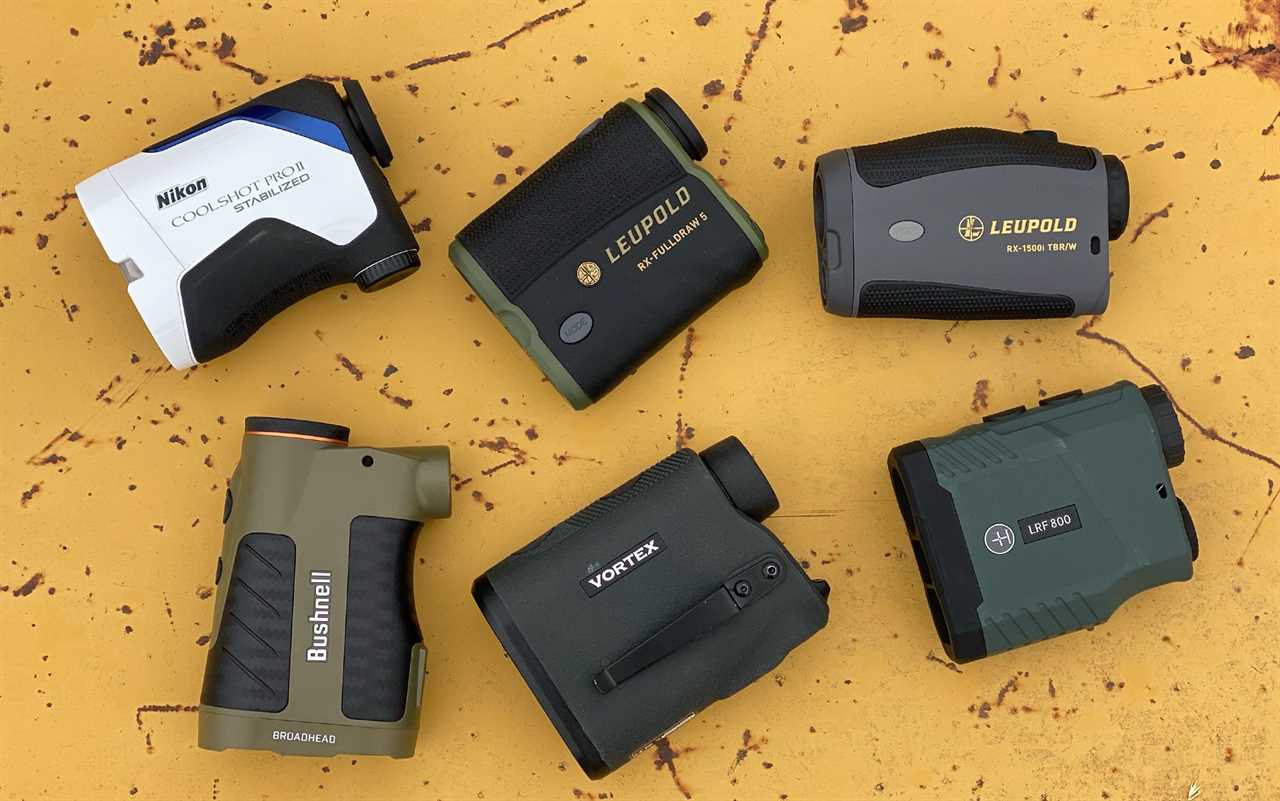
Monocular rangefinders are conveniently handheld, but don’t include the all-in-one features of rangefinding binoculars. Andrew McKean
This crop of new laser rangefinders for the year are handheld monoculars, simple rangefinders designed for use with a minimum of fuss interconnectivity.
Best Overall: Leupold 1500i TBR/W
Key Features
- Weight: 7 ounces
- Magnification: 6-power
- Objective Lens Diameter: 23mm
- Archer’s Advantage software
- Pre-loaded with 25 ballistics curves
- Line-of-sight, rifle, archery, last-target odes
- Stated Range: 6-1,500 yards
Pros
- Appealing price
- Simple operation
- Selectable reticles
- Both rifle and archery modes
Cons
- Not tripod compatible
- Black LCD display can be hard to see
A fresh antidote to the trend that adds features—and tedious complications—to laser rangefinders, this unit has everything a hunter needs in one of the best rangefinders for hunting, without add-ons that they’ll never use. If you’re a bowhunter, you’ll appreciate the bow mode that calculates angle-compensated ranges inside 125 yards. If you’re a rifle hunter, you’ll want to use the True Ballistic Range/Wind technology that allows users to select from any of the 25 pre-configured ballistics families. It’s a fast, precise, extremely user-friendly rangefinder that has the added benefit of being affordable, clocking in under $300.
We wish there was a receiver for a tripod stud, and the black LCD display sometimes got lost against a dark and cluttered background. But the ranging talents of the 1500i exceeded the advertised claims, and the hand-filling shape of the humpback unit is easy to stabilize.
Best for Archery: Leupold RX-FullDraw 5
Key Features
- Weight: 7.5 ounces
- Magnification: 6-power
- Objective Lens Diameter: 22mm
- Arrow ballistic software
- Line-of-sight, angle-compensating, and archery modes
- Arrow deflection notification
- Selectable reticles
- Stated Range: 6-1,200 yards
Pros
- Archer’s Advantage ballistics software is customizable
- Bright and crisp optics
- Essential for high-angle shots
- Accepts low-velocity inputs
- Arrow-obstruction alert
Cons
- Set-up is complicated
- Slow operation in ballistics mode
- Not tripod mountable
This is a rangefinder purpose-built for bowhunters and target archers. Load your arrow ballistics into the unit, set your zero for your 20-yard pin, and the unit will give you pin holds for various ranges out to 125 yards. The FullDraw is useful out to 1,100 yards (less than the advertised 1,200 yards), making it a decent rifle rangefinder, but in ballistics mode, it returns odd yardages both way out there and inside 20 yards. That makes this an excellent bowhunting unit for elk, mule deer, antelope, and other open-country game that routinely stretches the capabilities of standard rangefinders. If you’re going to use it outside those archery-specific distances, it works better (faster and with more precision) with the ballistics calculator turned off.
The Leupold has surprisingly good optics, given its tiny objective lens, and a menu of reticles, though members of our team gravitated to the open crosshair and the circle. The red OLED display pops against a variety of contrasty backgrounds.
We tested the unit in both treestand settings, where we ranged targets out to 40 yards, and in mountain settings, where we ranged targets out to 115 yards on extremely steep pitches. It excelled in this latter environment, which will be familiar to competitors in Total Archery Challenge events or during elk season. It’s worth noting that the low-velocity inputs make this a very useful unit for traditional archers. The sophisticated archery-specific software and accurate range finding make this the best rangefinder for bowhunting.
Read the full Leupold RX FullDraw 5 review for more information.
Best for Rifles: Vortex Diamondback HD 2000
Key Features
- Weight: 7.6 ounces
- Magnification: 7-power
- Objective Lens Diameter: 24mm
- Line-of-sight and angle-compensating modes
- Best and last target modes
- Premium case and lanyard
- Ambidextrous pocket clip
- Stated Range: 10-2,000 yards
Pros
- Better than advertised range
- Fast target return
- Strong pocket clip
- Simple operation
- Excellent warranty
- Tripod adaptable
Cons
- Imprecise targeting beyond 1,500 yards
- Peripheral distortion
- Mode button hard to find with gloves
This do-it-all rangefinder exceeded advertised ranges in every mode and target setting. We got readings of over 2,300 yards on trees in the Best Target mode. Its menu is easy to navigate, the laser processor is crazy-fast, and the amenities—soft case, wrist lanyard, pocket clip, and tripod receiver—add to its out-of-the-box utility. In short, it’s an excellent all-around rifle rangefinder, but it has plenty of talents for bowhunters, including a very good angle-adjusted mode that informs aiming solutions for high-angle shots.
If we have a ding on the Diamondback, it’s a beam-divergence issue that all testers experienced when ranging targets beyond about 1,400 yards. Beyond that range, the unit needs to be stabilized on a tripod or other support in order to ensure the laser is hitting the intended target. When handheld, the unit is too shaky to get reliable readings at those long ranges. But for nearly all shooting situations, this is a reliable and simple unit that should provide years of service. And if it doesn’t, you can rely on Vortex’s excellent warranty.
Best Budget: Hawke LRF 800
Key Features
- Weight: 4.6 ounces
- Magnification: 6-power
- Objective Lens Diameter: 25mm
- Last, best, fog, and golf target modes
- LCD display
Pros
- Very affordable
- Lightweight
- Multiple target modes
- Simple operation
Cons
- Flimsy feeling
- No angle-compensation mode
- Murky optics
It’s easy to talk about what this rangefinder doesn’t have—angle-compensating mode, ballistic calculator, and transferable warranty. But let’s first talk about what it does have, which is a crazy low price of around $150. It’s a basic, utilitarian rangefinder that delivers quick, accurate ranging out to just shy of 800 yards. The display—using icons to denote the various modes—is simple and intuitive. We have some concerns about durability, but the Hawke is light and showed no signs during the test of fatigue or failure, which is a good thing since a 2-year non-transferable warranty covers the unit.
The winning price is worth a few more words. Many beginning hunters and shooters invest in guns and optics but not rangefinders, both because they don’t fully appreciate the benefits of knowing precise yardage to a target and because many of these units are priced out of the range of beginning hunters. The Hawke goes a long way to making shooters and hunters of any experience more accurate and successful.
Bushnell Broadhead
Key Features
- Weight: 5.9 ounces
- Magnification: 6-power
- Objective Lens Diameter: 24mm
- Arrow ballistics informed by ARC technology
- Close-in (sub 150 yards) precision
- ActivSynch display
- Stated Range: 10-1,500 yards
Pros
- Tripod mountable
- Scan, bullseye, and brush targeting modes
- ActivSynch display visible in all light conditions
- Bow-calibrated ARC technology
- Selectable reticles
- Fast operation in scan mode
Cons
- Fairly dark optics
- Couldn’t achieve claimed distance range
An archery-configured rangefinder, this unit would be at home on a Total Archery Challenge course, where competitors must thread arrows through small openings and shoot in a wide variety of pitches and distances. The same could be said for its value as a treestand aid, especially for those hunters who often must shoot above or below a limb or other obstacle. Appealing features include Bushnell‘s genius ActivSynch display, which shows up as high-contrast black in full light but automatically switches to a red LCD in low-light conditions. We also loved the hand-filling ergonomics that minimized shaking of the very light (5.9-ounce unit) and allowed us to lock in targets. It’s also the most visually sharp monocular in our test.
While we struggled to get the 1,500-yard distance claimed by Bushnell, we routinely picked up targets out to 1,200. The unit does its most precise ranging inside 150 yards, as befits an archery rangefinder, and it’s worth noting that the company’s claim of close-in precision is spot-on. We were able to make incremental adjustments of under a half yard through a 3-D archery course with targets from 12 to 110 yards during testing. We liked the selectable reticles, though we routinely went with the very precise dot. Archers who have to make quick-range readings would probably go for the open circle.
Nikon Coolshot Pro II Stabilized
Key Features
- Weight: 6.3 ounces
- Magnification: 6-power
- Objective Lens Diameter: 21mm
- Line-of-sight and angle-compensating modes
- Best and last target modes
- Audible target-lock alert
- Stabilization feature
Pros
- Stabilization allows ranging with shaky hands
- Fast target return
- Red LED is easy to see, even when dimmed
- Simple operation
- Ergonomic shape
Cons
- Unit is white and very shiny
- No tripod adapter
- Murky optics
Ever tried ranging from a boat? Nearly impossible with a standard unit, but it’s a cinch with this stabilized rangefinder, which is equally invaluable in those hunting situations when your nerves unravel, and your hands shake. Like when a bugling bull strides into range. Or when a trophy buck hangs up on the edge of bow range, and you must know the yardage to make a killing shot.
Nikon had a less flashy (this one is shiny and very white) stabilized rangefinder a couple years ago, and while we wish they’d bring back that more subdued version, this one is worth a look. In fact, three of our testers bought the Coolshot after our testing was over, either to give to aging friends or to a hunting buddy with MS that causes uncontrollable shaking. The Nikon allowed this hunter to return to the field with confidence.
We liked the hand-filling ergonomics of the Coolshot, and the optics were very good considering the tiny 21mm objective lens. We actually really liked the audible confirmation of locking into a target, but that’s a feature that archery hunters will probably want to disable. Same with the external green light that shines when the angle-adjusted mode is turned off.
Best for Tech Dummies: Maven RF.1
Key Features
- External mode selector
- 4,500 yard range
- Dimmable display knob
Pros
- Tripod mount
- External controls are easy to access and use
- 5-yard minimum ranging appeals to bowhunters
- Choice of five different reticle styles
Cons
- Very large external dimensions
- Real-world ranging limit at 3,800 yards
- Mode selector easy to inadvertently move
- No connection to ballistic app
This direct-to-consumer brand has made its name by offering very good optics without middleman pricing, and the RF.1 is no exception. The 7x magnification is just right for a variety of hunting and shooting purposes, and for users who don’t have the patience or digital skills to toggle through several modes in the internal display, the main functions are controllable on the outside of the unit and include targeting preference and the display intensity functions.
A very useful and durable rangefinder, Maven’s RF.1 has everything a big-game hunter needs. The external mode selector toggles between Field and Forest functions; Field for acquiring small, precise targets and Forest for acquiring targets behind veiling branches and rain. The rheostat dial that controls display intensity is a useful feature for hunters who want full display intensity in the middle of the day but subdued red LED for low-light conditions. Users can choose between line-of-sight and angle-compensated viewing preferences. I wish the unit paired with a ballistic app, but it’s a solid stand-alone rangefinder.
Things to Consider Before Buying a Laser Rangefinder
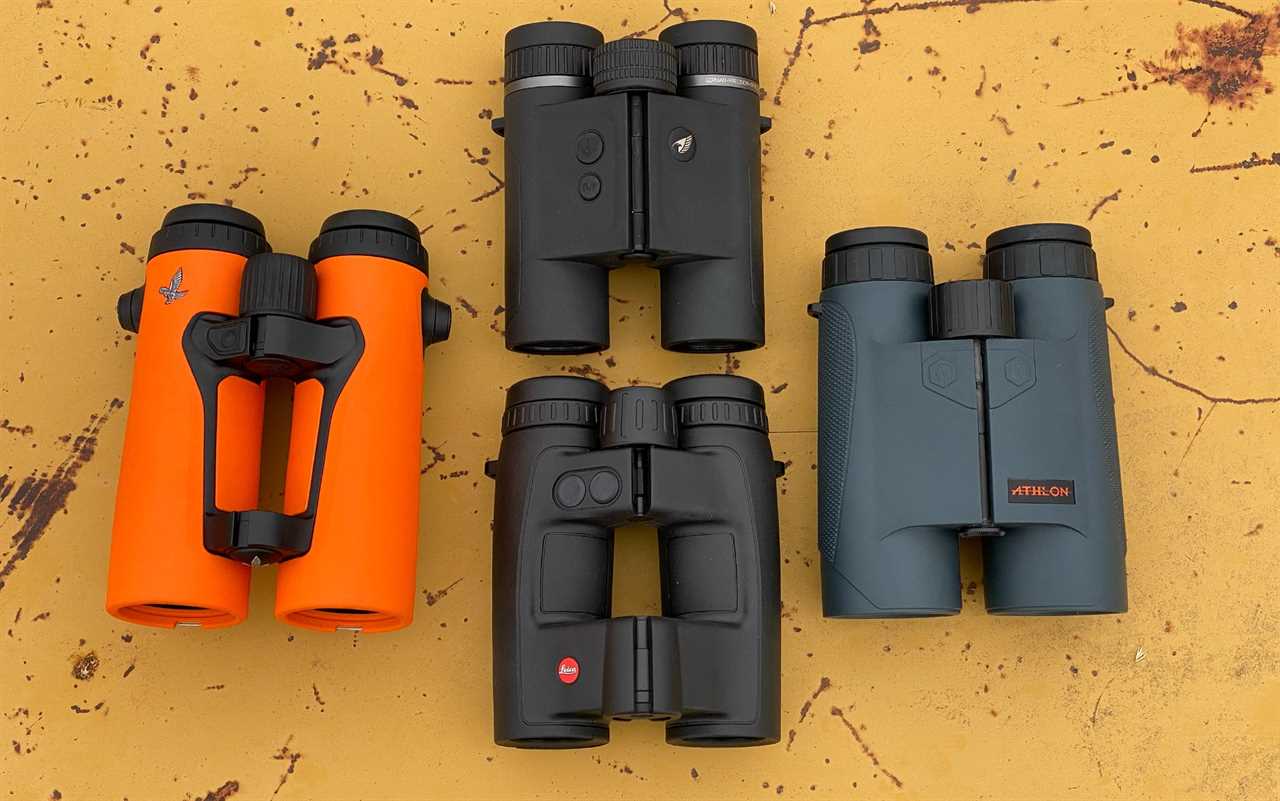
We tested the best rangefinding binoculars on the same field as the monocular rangefinders. Andrew McKean
This question, of the key things to consider before buying a laser rangefinder, is more critical than ever. That’s because these little pocket calculators are capable of so much computation that the most complicated ones require a steep learning curve to operate effectively. And they probably have too many features for buyers looking for a simple, durable unit that simply ranges distant targets.
So the first question is: what will you use the laser rangefinder for? Are you a long-range steel ringer who needs onboard ballistics and wind adjustments? Then you probably want a unit with Bluetooth connectivity to a ballistics app. Are you a bowhunter who just needs angle-compensated readings inside 100 yards? Then consider one of the archery-specific units with software that you can use (or not) to conform to your bow’s ballistics. Maybe you want your rangefinder to pair with a map of the area you’re hunting—a new feature that allows hunters to more effectively recover game.
You should also consider whether you want an all-in-one binocular and rangefinder. The rangefinding binoculars in this test have features for shooters all along the use and experience continuum. Or maybe you want a handheld monocular. Check out the Hawke for a budget-friendly basic unit, or one of the bow-specific models (the Bushnell Broadhead and Leupold FullDraw) for more sophisticated units with archery-specific features.
Lastly, how much do you want to spend on a laser rangefinder? There are units in our test that range from about $150 all the way up to nearly $4,000.
FAQs
Q: How does a rangefinder work?
The simplest laser rangefinders work by measuring the time a laser beam leaves the device to when it returns. Obviously, this happens at the speed of light, so laser rangefinders have very precise clocks that can measure in nanoseconds. The more sophisticated laser rangefinders also have an inclinometer, or some level that can measure the angle of the device, which helps measure the angle-compensated distance between the unit and the target. And still others have software that combines the distance readings with the ballistics of your rifle, to help you adjust your aim for specific distances and angles.
Q: What’s the best rangefinder for under $200?
Is it possible to buy a serviceable laser rangefinder for under $200? The easy answer is yes. A couple of models to consider are Bushnell’s Prime 1300 or Prime 1700 units. The numeric designations in the models are a give-away for their ranging capabilities: the Prime 1300 is rated to range highly reflective targets at 1,300 yards, and the Prime 1700 at distances just over a mile. In the real world of deer hunting, their range is about 600 and 700 yards, respectively. The good thing about these units is that they both have incline-adjusting ranging as well as scanning modes.
You might also consider Hawke’s 400 LRF and 800 LRF models, both of which sell for under $170. The limitation to these models is that they provide only line-of-sight ranging, with no incline-adjusted aiming solution, and neither have scan modes. Lastly, Sig has a $152 rangefinder, the Buckmasters 1500, that has a bullet-drop compensation reticle that provides holdover dots out to 500 yards that conform to the bullet drop of eight different ballistic groups.
Q: Do I need a rangefinder with incline-adjusted ranging mode?
If you do most of your shooting and hunting in flat terrain, you might not need an inclinometer, but the minute you climb into a treestand to hunt deer or you try to make a shot on a target that’s slightly higher or lower than your gun or bow, you’ll want a rangefinder with the ability to find the “true” distance to an inclined target. At modest angles, say inside 6 degrees, with targets inside about 200 yards, you won’t see a huge difference in what’s called line-of-sight ranging and incline-adjusted ranging. But as both angles and distances increase, the linear distance can be several yards different from the angle-compensated distance. That means you’d shoot the legs off, say, a mountain goat standing 500 yards away on a ridge that’s 250 feet higher in elevation than you are. Or you’d miss entirely a 1,000 yard standard steel target that’s only 10 feet lower in elevation. Inclinometers are pretty much standard on most rangefinders, and you should get comfortable switching between angular and line-of-sight modes.
Q: Which rangefinders have the clearest glass?
Not all laser rangefinders are equal when it comes to their optics, and generally the models from companies that make binoculars and riflescopes have the best glass and clearest coatings. But here’s the deal: you really aren’t buying a laser rangefinder for its optical clarity; you’re buying it for the electronics—the laser and distance-computing software. All things being equal, I’d buy a unit with better and more sophisticated electronics. But you can’t range what you can’t see, and optics make a huge difference. I like units from Leica, Maven, and Leupold for the quality of glass in their builds, and in the coatings that not only accentuate your target, but also boost the visibility of the display.
Q: What are the best Sig rangefinders?
Sig has one of the most complete lines of laser rangefinders in the industry. Stepping up in price and performance is the entry-level Buckmasters 1500 ($152), and the KILO1000BDX ($250) that pairs with Sig’s versatile BDX system of sports optics. The KILO1600 will range deer-sized targets out to 800 yards and has both angle-modified and line-of-sight ranging and Sig’s ultra-fast ranging engine. Sig has developed a growing family of precision-shooting rangefinders, and the best of the monocular styles is the KILO8K-ABS, a 7x25mm unit that has a maximum range of 8,000 yards and uses Applied Ballistics Elite custom ballistics profiles along with onboard environmental sensors and a digital compass to churn out hyper-precise aiming solutions for just about any long-range target range.
Another monocular to consider is the KILO5K, which has a range of 5,000 yards and uses Applied Ballistics Ultralite ballistics curves but also pairs with Kestrel and Garmin devices for even more precise aiming, and with BaseMap for geo-location. It also pairs with Sig’s BDX family. Lastly, the wildly sophisticated KILO10K-ABS rangefinding binocular brings in all the precision shooting software with a heads-up display that provides all relevant ballistics information—including range, elevation and wind holds, and bullet velocity and energy at target—in the display. So making hyper-informed aiming decisions is as easy as ranging the target, and following directions in the display.
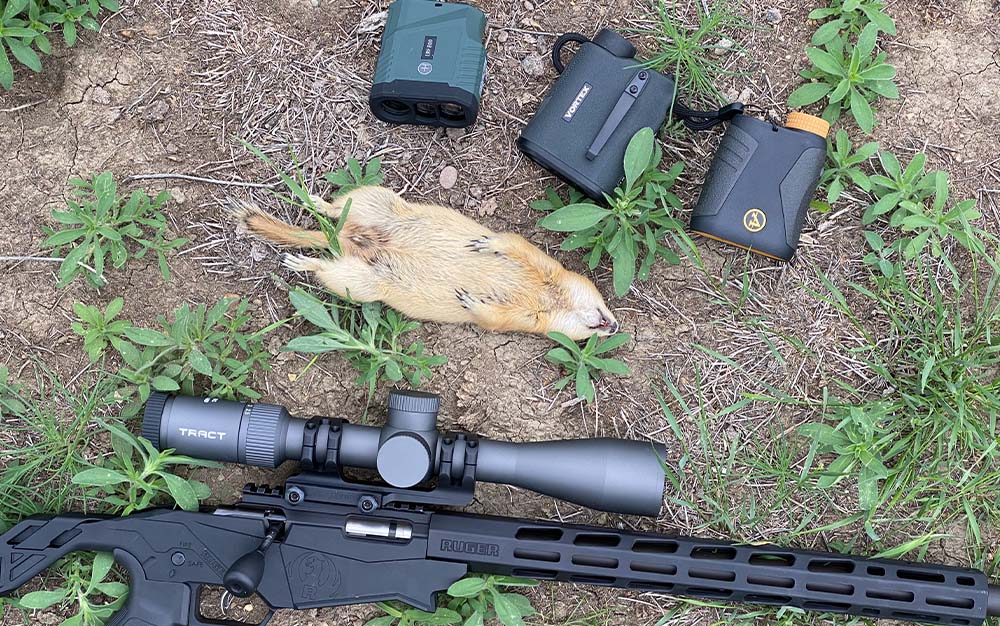
A solid rangefinder can help you dial in your shots on even the smallest targets. Andrew McKean
Methodology
We solicited brands for their new models, then divided the field into rangefinding binoculars and handheld rangefinding monoculars. We then weighed and assessed the physical dimensions of each unit before putting them through a ranging course, which included an array of targets from 7 to 4,000 yards. It’s important to note that these included a variety of surfaces, from highly reflective (where laser rangefinders often do their best ranging work) to textured, stippled surfaces that often confuse lasers. I tested on 3-D archery targets, metal grain bins, forested hillsides, cattle, and distant rocks. I tested in full daylight and twilight conditions and in fog and rain. I ranged using each mode, from line-of-sight to incline-adjusted, and various target modes. For those units with selectable reticles, I ranged using each reticle type.
I employed the perspectives of three other testers, each of whom put the units through their own ranging course. I gathered the results, and averaged the various distances, but the maximum distance in each mode was also noted.
For those units that link to mobile apps, I downloaded the apps and assessed their ease of use, ability to customize, and any extras.
Lastly, I assessed the extras, including the accessories that it ships with and each submission’s warranty. And I also considered warranty terms. I picked one overall winner to receive our Editor’s Choice award—this year, that goes to Leica’s ground-breaking Geovid Pro 32—and the unit that scored highest on our Price/Value assessment wins our Great Buy award. This year that goes to Hawke’s Laser Range Finder 800.
Why Trust Outdoor Life?
Since 1898, OL has been a leading authority in testing and reviewing hunting gear, fishing tackle, guns and shooting equipment, and much more. We have more than a century-long history of evaluating products, and we’re now bringing that expertise to online reviews. Our editors are experienced outdoorsmen and women, and most importantly, we’re trained journalists. We prioritize field testing and objective data when reviewing products. We conduct interviews with gear manufacturers and engineers as well as outdoor experts so that our readers have an understanding of how and why a product works—or doesn’t.
Advertising does not influence our gear reviews and it never will. While we always focus our coverage on standout products—because we want our readers to be aware of the latest and greatest gear—we also cover the flaws and quirks of any given product.
Final Thoughts
Every entry in the laser rangefinder category in this year’s optics test will capably handle the basics: delivering precise ranges to distant targets in order for you to make an accurate shot, whether with a bullet or an arrow. But some simply do that job with more style, precision, and customizable features. Because these are sophisticated electronics, you should consider the warranty details. Many companies that offer fully transferrable lifetime warranties on their optics have more limited terms for their electronics, including the best rangefinders for hunting.
Rangefinding Binoculars
- Best Overall: Leica Geovid Pro 32 10×32
- Best for Game-Tracking: Swarovski EL Range TA 10×42
- Best Budget: GPO Rangeguide 2800 8×32
- Athlon Cronos UHD
Monocular Rangefinders
- Best Overall: Leupold 1500i TBR/W
- Best for Archery: Leupold RX-FullDraw 5
- Best for Rifles: Vortex Diamondback HD 2000
- Best Budget: Hawke LRF 800
- Bushnell Broadhead
- Nikon Coolshot Pro II Stabilized
- Best for Tech Dummies: Maven RF.1
The post The Best Rangefinders for Hunting of 2023 appeared first on Outdoor Life.
Articles may contain affiliate links which enable us to share in the revenue of any purchases made.
By: Andrew McKean
Title: The Best Rangefinders for Hunting of 2023
Sourced From: www.outdoorlife.com/gear/best-rangefinders-for-hunting/
Published Date: Sat, 18 Sep 2021 16:00:00 +0000
----------------------------------------------
 Backyard GrillingWeekend WarriorsAdvice from DadBeard GroomingTV Shows for Guys4x4 Off-Road CarsMens FashionSports NewsAncient Archeology World NewsPrivacy PolicyTerms And Conditions
Backyard GrillingWeekend WarriorsAdvice from DadBeard GroomingTV Shows for Guys4x4 Off-Road CarsMens FashionSports NewsAncient Archeology World NewsPrivacy PolicyTerms And Conditions
